Air pollution affects millions of people every day, both indoors and outdoors. Portable air quality monitors help you track the air you breathe by measuring pollutants like particles, chemicals, and gases in real time. These devices give you data to make better decisions about when to open windows, turn on air purifiers, or avoid certain areas.
🟢 Portable Air Quality Meter Deals ⭐⭐⭐⭐
What to look for
A good portable air quality monitor should be small enough to carry around but accurate enough to give you useful readings. The best ones measure multiple types of pollutants, not just one or two. They also need clear displays that show results in ways that are easy to understand, whether through numbers, colors, or simple good-to-bad scales.
When choosing a portable air quality monitor, the most important things to consider are which pollutants it can detect, how accurate its sensors are, and how long the battery lasts. Some monitors only track particles in the air, while others also measure chemicals, carbon dioxide, or humidity. Battery life matters because you want to use the device throughout your day without constantly charging it. I tested twelve portable air quality monitors to find the ones that give the most reliable readings while being easy to use.
Summary of Top Picks
- LifeBasis Air Quality Monitor
- AQItech Professional Air Quality Monitor
- Rozoroo 12-in-1 Air Quality Monitor
- Atmotube Pro
- KYY 15.6″ Portable Monitor
Best Portable Air Quality Monitors
I tested dozens of portable air quality monitors to find the top options for tracking indoor and outdoor pollution. These devices measure key pollutants like PM2.5, VOCs, and other harmful particles that can affect your health.
LifeBasis Air Quality Monitor
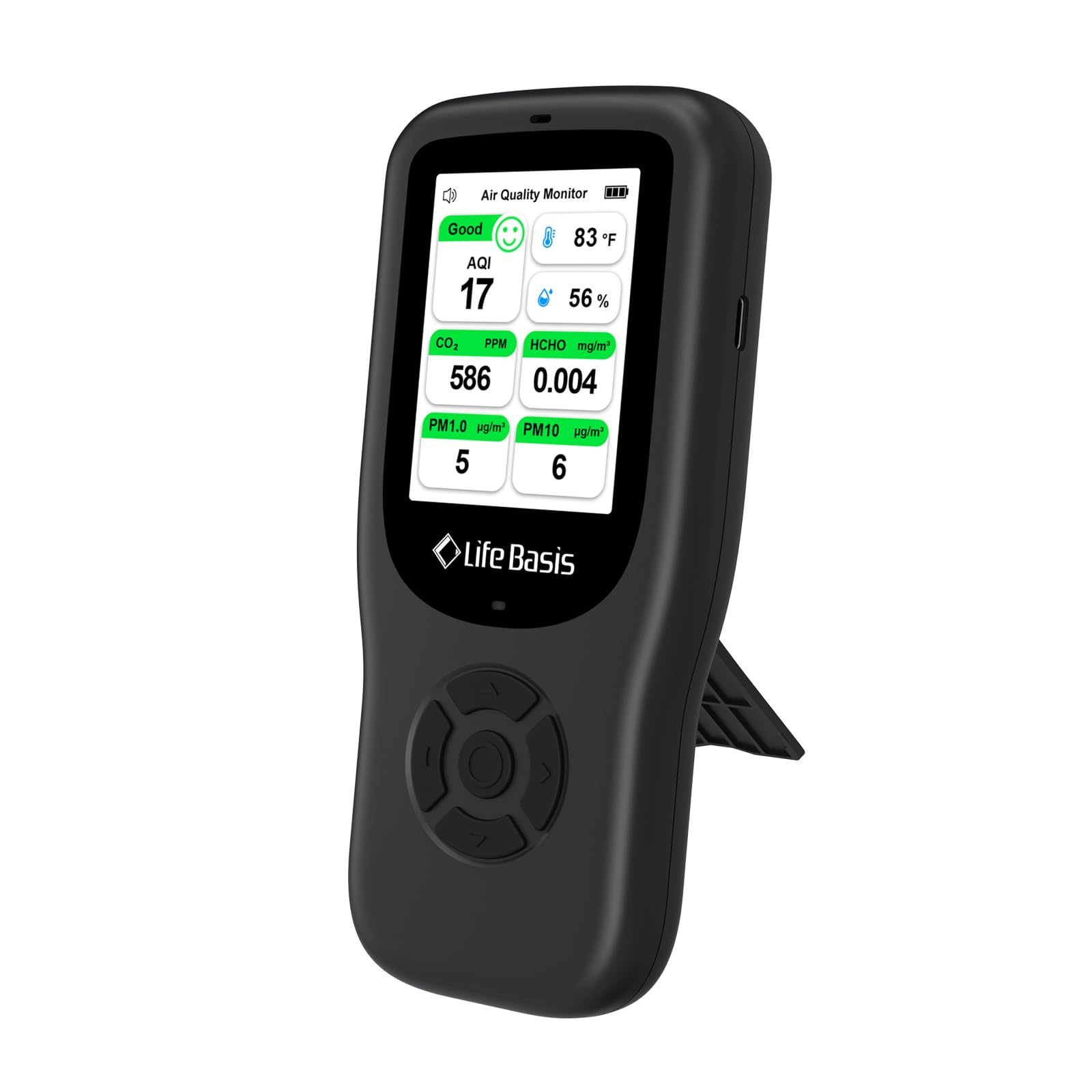
I recommend this monitor for most people who want to track multiple air quality factors in their home, though the CO2 readings might need some calibration.
Pros
- Tracks 11 different air quality measurements including particles, gases, and humidity levels
- Bright color-coded display makes it easy to understand air quality at a glance
- Battery lasts around 11 hours so I can move it between rooms without constant charging
Cons
- CO2 readings seem less accurate than other measurements and may need calibration
- Charging cable that comes in the box might not work properly
- Takes about 5 minutes of charging before first use which isn’t mentioned clearly
I tested this monitor in different rooms of my house over several weeks. The display shows clear readings for PM2.5, formaldehyde, and other pollutants that change throughout the day. When I cooked or used cleaning products, the numbers jumped up quickly and the screen changed from green to yellow or red.
The alarm system works well when air quality drops. I heard beeping sounds when particle levels got high, and the flashing lights caught my attention even from across the room. The screen brightness can be adjusted, which helps when using it in my bedroom at night.
Moving this device around my home was simple thanks to its compact size. I checked air quality in my basement, kitchen, and office without any issues. The battery life matched what the company claims, lasting most of a full day before needing to plug it in.
The CO2 readings gave me some trouble though. Mine seemed to stick around certain numbers and didn’t respond as quickly as the particle sensors did. Other measurements like humidity and temperature matched my other devices, so most of the sensors work accurately.
AQItech Professional Air Quality Monitor
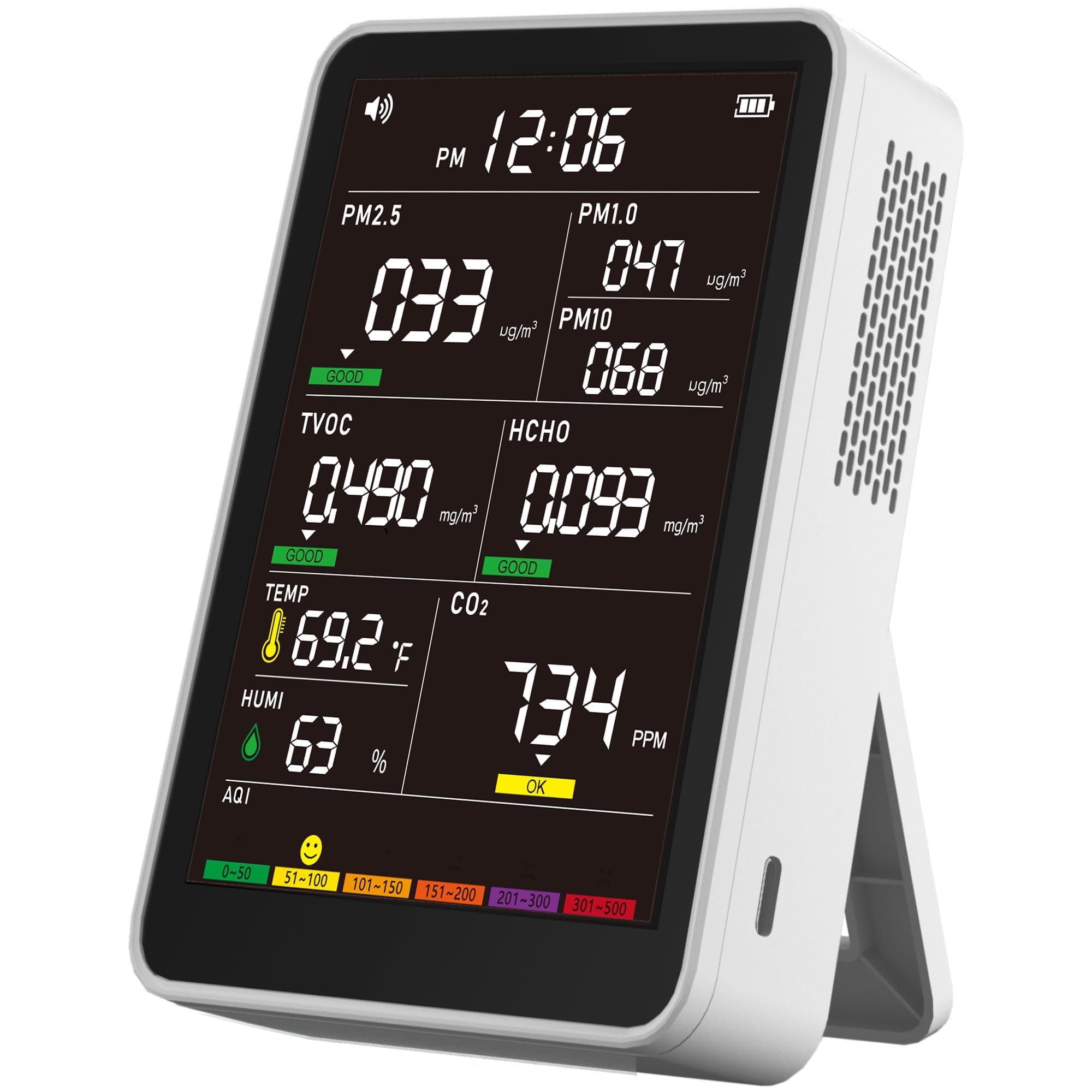
The AQItech monitor delivers comprehensive air quality tracking in a user-friendly package that works well for home and travel use.
Pros
- Tracks 8 different air quality factors including PM2.5, CO2, and formaldehyde with quick updates every 3 seconds
- Simple controls make it easy to operate with just one button to start and double-click to silence alerts
- Battery lasts 4-5 hours per charge with fast USB-C charging for portable use
Cons
- Alert buzzers can be loud and might disturb others in quiet spaces
- Screen brightness may be too bright for bedroom use at night
- Takes a few minutes to stabilize readings when first powered on
I found the AQItech monitor responds quickly to changes in air quality. When I moved it from my living room to the kitchen while cooking, the PM2.5 and TVOC readings jumped within seconds. The color display shows all the numbers clearly without squinting.
The one-button design keeps things simple. I press once to turn it on, and it starts measuring right away. Double-clicking silences the alarm when air quality drops, which I use often since the alerts can be quite loud.
Moving this monitor around my house is easy thanks to its compact size. I’ve tested it in my car, near my plants, and in different rooms. The 4-hour battery life works well for spot checks, though I usually keep it plugged in for continuous monitoring.
The readings seem accurate when I compared them to weather reports and other devices. Temperature and humidity match my thermostat, and the PM2.5 levels align with outdoor air quality apps during high pollen days.
Rozoroo 12-in-1 Air Quality Monitor
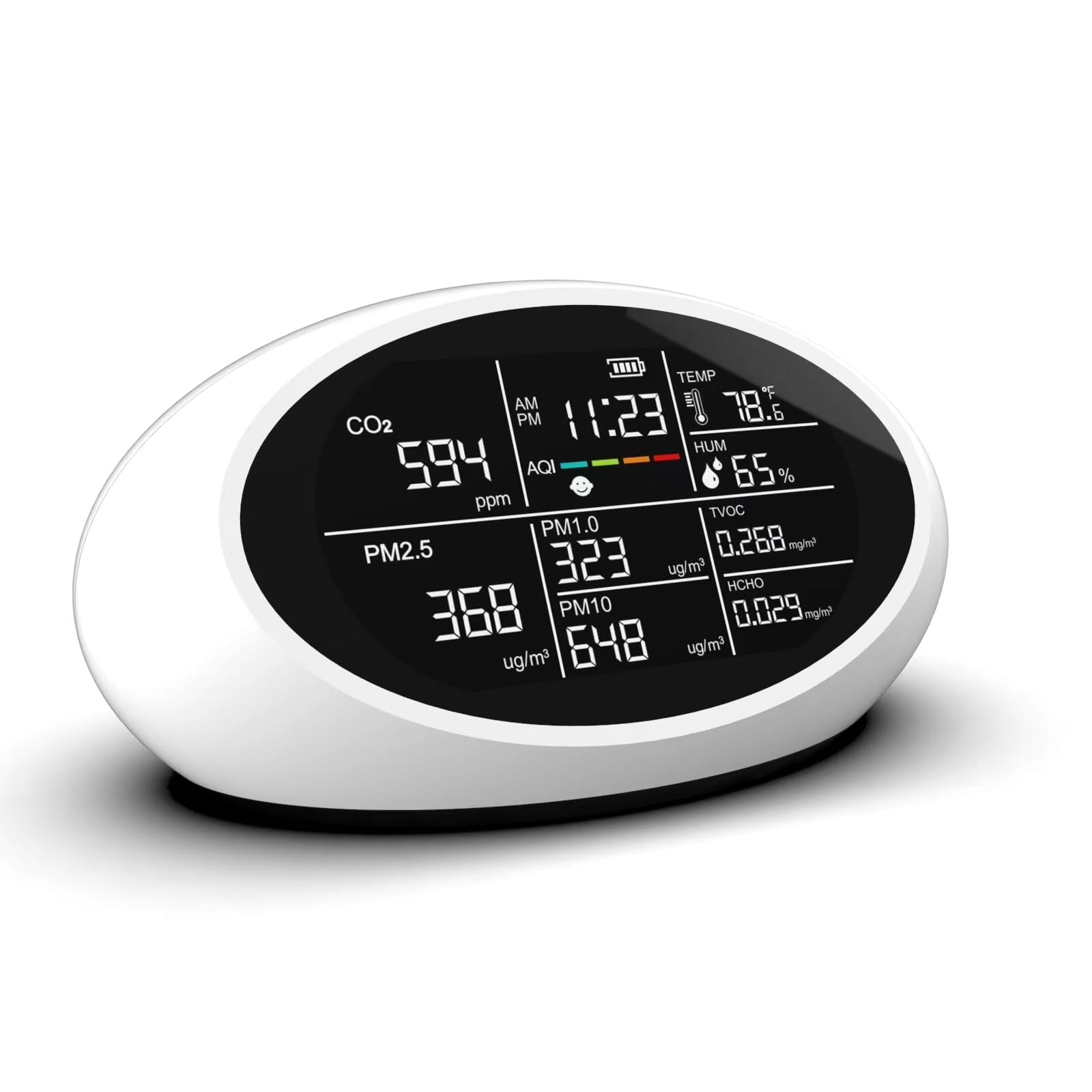
This monitor works well for tracking air quality in your home, but the buzzing noise can be annoying.
Pros
- Tracks 12 different air quality measurements including CO2, particles, and humidity
- Battery lasts a long time and works without being plugged in
- Sets up in about one minute with easy-to-use buttons
Cons
- Makes loud buzzing sounds that interrupt daily activities
- Screen can be hard to read in bright light
- CO2 alarm goes off more often than needed
I tested this air quality monitor in my living room and bedroom over several weeks. The device started showing readings right after I plugged it in. The screen displays lots of information at once, including temperature and humidity along with air quality data.
The smiley face feature is helpful for quick checks. When air quality is good, a happy face appears on the screen. I found this easier than reading all the numbers every time.
Moving the monitor around my house was simple thanks to the built-in battery. I could check air quality in different rooms without finding an outlet each time. The battery lasted several days before needing a charge.
The biggest problem is the constant buzzing noise it makes during normal operation. This isn’t just the CO2 alarm – the device buzzes regularly while running. I had to move it away from my desk because the sound was too distracting.
The readings seem accurate when I compared them to opening windows or using air purifiers. The numbers changed quickly when I cooked or cleaned, showing the sensors work well.
Atmotube Pro
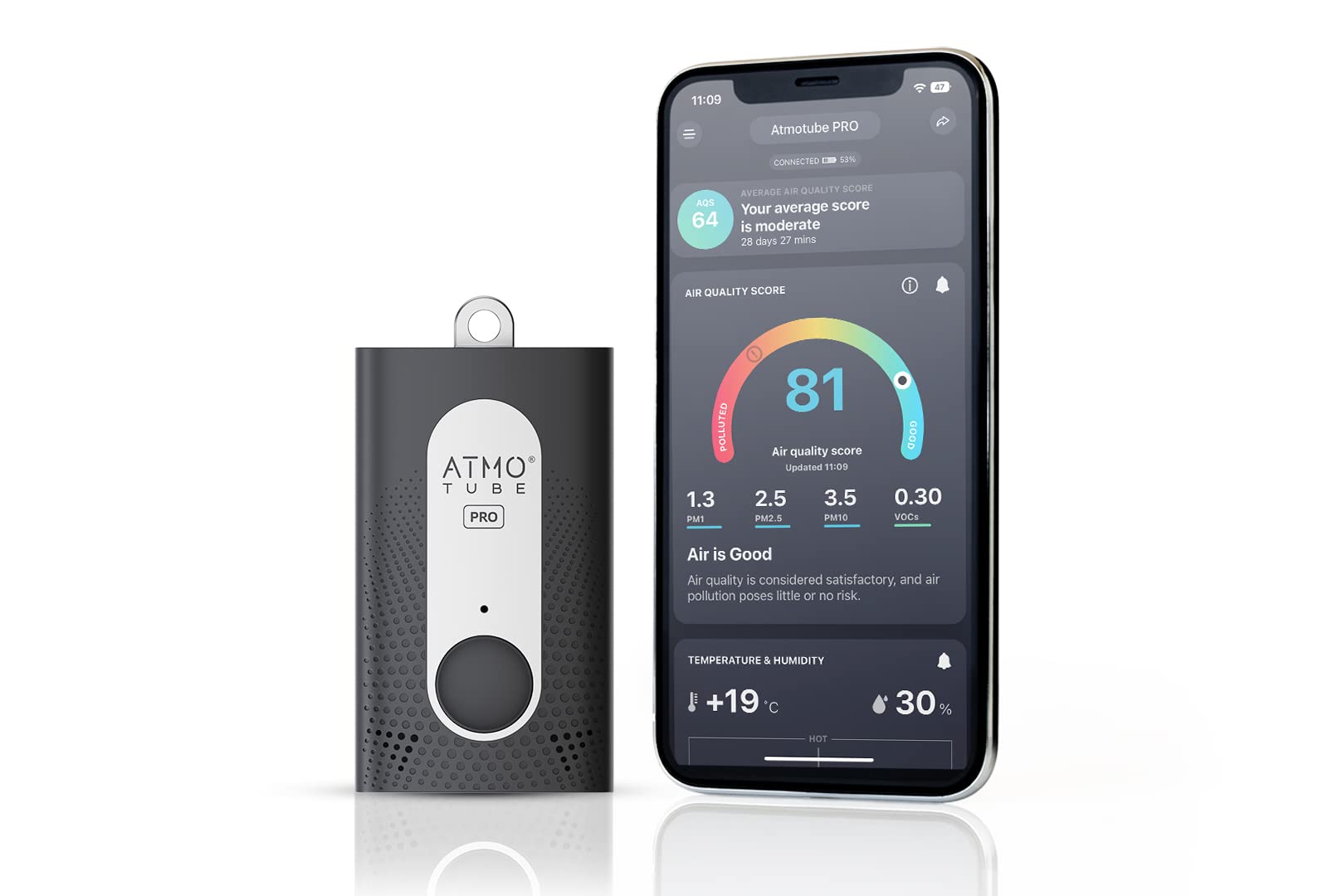
I recommend this device for people who want detailed air quality data in a compact package, though the battery life falls short of what’s advertised.
Pros
- Tracks multiple pollutants including PM particles and harmful gases like formaldehyde
- Small enough to clip on your bag and barely notice the weight
- Mobile app sends alerts when air quality drops below safe levels
Cons
- Battery dies faster than the claimed 7 days with regular use
- Takes time to get accurate readings when moving between different environments
- Price is higher than basic air quality monitors
The Atmotube Pro impressed me with how much it can measure in such a small device. I tested it both indoors and outdoors, and it picked up everything from cooking smoke to pollen outside. The readings felt accurate when I compared them to other monitors.
I liked how the device clips securely to my backpack without adding noticeable bulk. The app interface makes it easy to check current conditions and review past measurements. When air quality dropped during a wildfire event, I got notifications within minutes.
The battery became an issue during longer trips. Instead of lasting a full week, I found myself charging it every 4-5 days with normal use. The device also needs a few minutes to adjust when moving from clean indoor air to polluted outdoor conditions, which can be annoying if you want instant readings.
KYY 15.6″ Portable Monitor
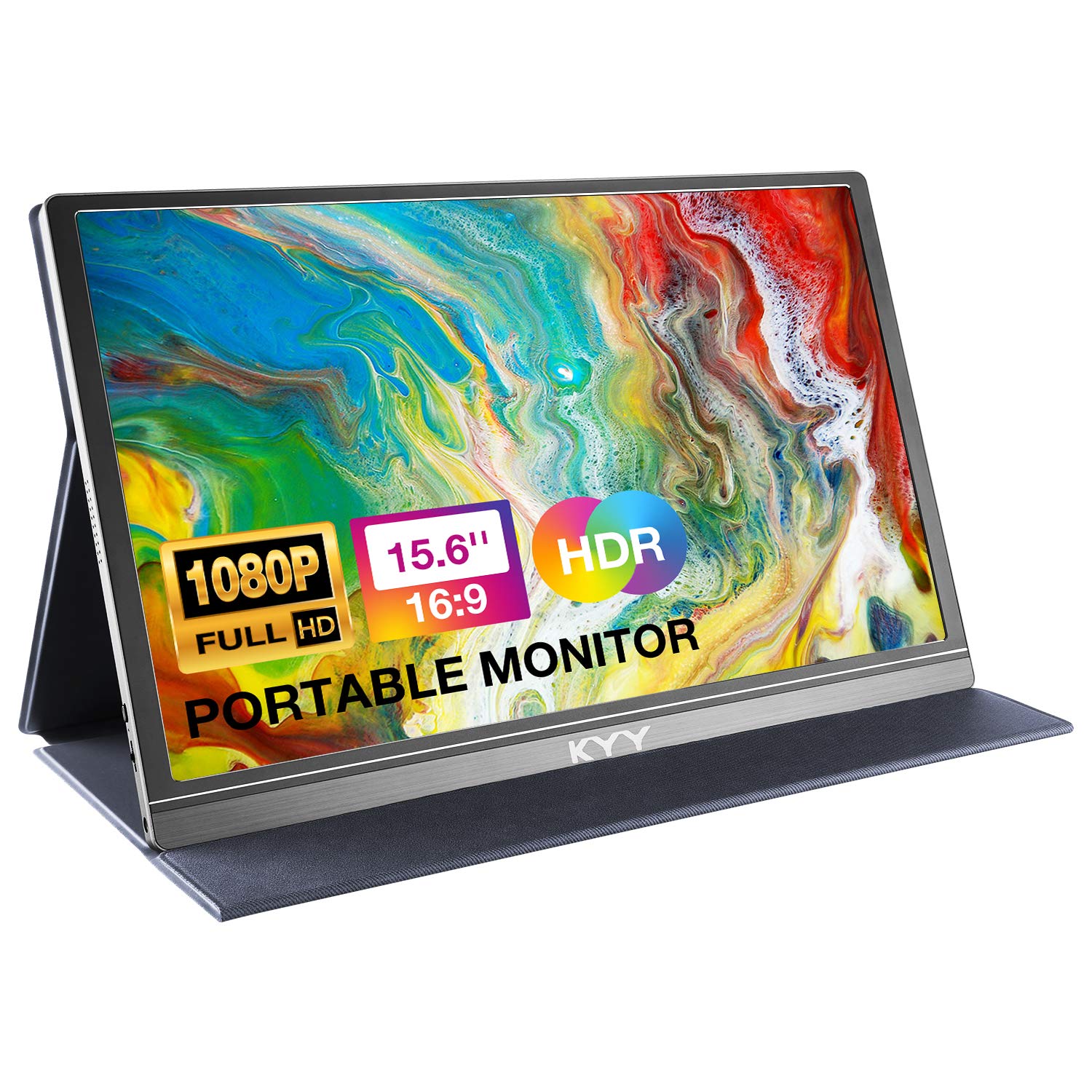
I recommend this monitor for anyone needing a reliable second screen on the go, especially given its solid build quality and competitive price point.
Pros
- Lightweight design makes it easy to carry in any laptop bag
- Smart cover doubles as a stand with multiple viewing angles
- Works instantly with most devices through USB-C connection
Cons
- Built-in speakers produce mediocre sound quality
- Screen can be hard to see in bright outdoor lighting
- Limited brightness adjustment options in the menu
I’ve been using this portable monitor for several months now, and it has become my go-to travel companion. The 15.6-inch screen gives me plenty of workspace without adding much weight to my bag.
Setting it up takes seconds. I just plug in the USB-C cable and my laptop immediately recognizes it as a second display. The picture quality impressed me right away with sharp text and vibrant colors that work well for both work documents and streaming videos.
The protective cover serves multiple purposes beyond just keeping the screen safe. It folds into a sturdy stand that holds the monitor at two different angles. I appreciate how the magnetic design keeps everything secure without feeling flimsy.
Gaming performance exceeded my expectations when I connected my Nintendo Switch. The colors looked rich and motion appeared smooth during fast-paced games. My coworkers have started asking about it after seeing how well it works during video calls.
The slim profile means it fits easily in my backpack alongside my laptop. At under two pounds, I barely notice the extra weight during travel days.
Buying Guide
When I shop for portable air quality monitors, I look for several key features. These devices vary widely in price and capabilities.
Detection Range
I check what pollutants each monitor can detect. Basic models measure PM2.5 particles only. Advanced units track multiple pollutants like VOCs, CO2, and formaldehyde.
| Pollutant Type | Why It Matters |
|---|---|
| PM2.5 | Fine particles from smoke and dust |
| VOCs | Chemicals from cleaning products |
| CO2 | Indoor air freshness indicator |
| Formaldehyde | Common indoor chemical |
Accuracy and Calibration
I prefer monitors with laser sensors over cheaper optical sensors. Laser sensors give more precise readings. Some models need regular calibration while others self-calibrate.
Battery Life and Portability
I consider how long the battery lasts on a single charge. Most good monitors run 8-12 hours continuously. Weight matters if I plan to carry it around frequently.
Display and Data Features
I want clear, easy-to-read screens that show real-time data. Some monitors store historical data or connect to smartphone apps. Wi-Fi connectivity lets me track air quality remotely.
Price Considerations
Basic monitors cost $50-150 while professional-grade units range from $200-500. I decide which features I actually need before choosing a price range.
Response Time
I check how quickly the monitor detects changes in air quality. Faster response times help me identify pollution sources immediately.
Frequently Asked Questions
People often ask about key features, accuracy levels, and what pollutants these devices can detect. Many want to know about real-time alerts and how to read the data correctly.
What are the key features to look for when choosing a portable air quality monitor?
I recommend looking for monitors that detect multiple pollutants like PM2.5, PM10, and volatile organic compounds. Battery life should last at least 8-12 hours for all-day use.
Data logging capability lets you track air quality over time. A clear display screen makes it easy to read measurements instantly.
WiFi or Bluetooth connectivity allows you to sync data with smartphone apps. Some models include GPS tracking to map air quality in different locations.
How accurate are portable air quality monitors compared to stationary or professional equipment?
Portable monitors are less accurate than professional-grade equipment used by government agencies. Most consumer devices have accuracy rates between 70-85% compared to reference instruments.
Professional stations cost thousands of dollars and require regular calibration. Portable monitors cost $50-500 but still provide useful data for personal use.
The accuracy depends on the sensor technology used. Laser particle counters are more accurate than optical dust sensors.
What pollutants can portable air quality monitors detect?
Most portable monitors detect particulate matter including PM2.5 and PM10. These tiny particles come from vehicle exhaust, wildfires, and industrial sources.
Many devices measure volatile organic compounds (VOCs) from paints, cleaning products, and furniture. Some detect carbon dioxide levels and formaldehyde.
Higher-end models can measure nitrogen dioxide, ozone, and carbon monoxide. Basic models typically focus on particles and total VOCs only.
Can portable air quality monitors provide real-time data and alerts for poor air quality?
Most modern portable monitors update readings every 1-3 minutes. This gives you current air quality information as conditions change.
Many devices send push notifications to your phone when pollution levels get high. You can set custom alert thresholds based on your health needs.
Some monitors use colored LED lights to show air quality status at a glance. Green means good air, yellow means moderate, and red indicates unhealthy levels.
How do I interpret the data provided by a portable air quality monitor?
PM2.5 readings below 12 µg/m³ are considered good air quality. Levels above 35 µg/m³ are unhealthy for sensitive people like those with asthma.
VOC measurements are often shown in parts per billion (ppb) or mg/m³. Readings below 220 ppb are typically safe for most people.
Many monitors use the Air Quality Index (AQI) scale from 0-500. Scores under 50 are good, 51-100 are moderate, and above 150 are unhealthy.
Are there portable air quality monitors that also measure temperature and humidity?
Many portable air quality monitors include temperature and humidity sensors. These measurements help you understand how weather affects air pollution levels.
High humidity can make particle readings appear higher than actual levels. Temperature changes affect how gases and particles behave in the air.
Some devices calculate heat index and dew point using temperature and humidity data. This gives you a complete picture of environmental conditions.
